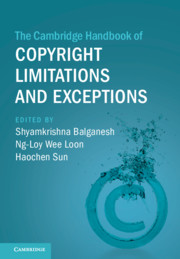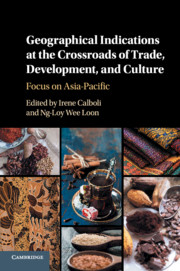38 results
Preface
-
- Book:
- The Cambridge Handbook of Copyright Limitations and Exceptions
- Published online:
- 15 January 2021
- Print publication:
- 07 January 2021, pp xi-xiv
-
- Chapter
- Export citation
Part IV - Obvious and Hidden Values in the Working of Copyright Exceptions
-
- Book:
- The Cambridge Handbook of Copyright Limitations and Exceptions
- Published online:
- 15 January 2021
- Print publication:
- 07 January 2021, pp 231-402
-
- Chapter
- Export citation
Part I - The Theoretical Foundation of Copyright Limitations
-
- Book:
- The Cambridge Handbook of Copyright Limitations and Exceptions
- Published online:
- 15 January 2021
- Print publication:
- 07 January 2021, pp 1-34
-
- Chapter
- Export citation
Copyright page
-
- Book:
- The Cambridge Handbook of Copyright Limitations and Exceptions
- Published online:
- 15 January 2021
- Print publication:
- 07 January 2021, pp iv-iv
-
- Chapter
- Export citation
Part II - Internationalizing Copyright Exceptions
-
- Book:
- The Cambridge Handbook of Copyright Limitations and Exceptions
- Published online:
- 15 January 2021
- Print publication:
- 07 January 2021, pp 35-108
-
- Chapter
- Export citation
Part V - Copyright Exceptions and Technology
-
- Book:
- The Cambridge Handbook of Copyright Limitations and Exceptions
- Published online:
- 15 January 2021
- Print publication:
- 07 January 2021, pp 403-404
-
- Chapter
- Export citation

The Cambridge Handbook of Copyright Limitations and Exceptions
-
- Published online:
- 15 January 2021
- Print publication:
- 07 January 2021
Contents
-
- Book:
- The Cambridge Handbook of Copyright Limitations and Exceptions
- Published online:
- 15 January 2021
- Print publication:
- 07 January 2021, pp v-vii
-
- Chapter
- Export citation
Part III - Models of Copyright Exceptions
-
- Book:
- The Cambridge Handbook of Copyright Limitations and Exceptions
- Published online:
- 15 January 2021
- Print publication:
- 07 January 2021, pp 109-230
-
- Chapter
- Export citation
Contributors
-
- Book:
- The Cambridge Handbook of Copyright Limitations and Exceptions
- Published online:
- 15 January 2021
- Print publication:
- 07 January 2021, pp viii-x
-
- Chapter
- Export citation
21 - Copyright and Religion: An Exemption for the Use of Music and Songs in Worship?
- from Part IV - Obvious and Hidden Values in the Working of Copyright Exceptions
-
-
- Book:
- The Cambridge Handbook of Copyright Limitations and Exceptions
- Published online:
- 15 January 2021
- Print publication:
- 07 January 2021, pp 389-402
-
- Chapter
- Export citation
25 - Relationship between Trademark Law and Copyright/Design Law
- from IX - Overlapping Rights
-
-
- Book:
- The Cambridge Handbook of International and Comparative Trademark Law
- Published online:
- 18 September 2020
- Print publication:
- 24 September 2020, pp 421-435
-
- Chapter
- Export citation
7 - Australian Legislation Abroad
- from Part II - Across Jurisdictions
-
-
- Book:
- Across Intellectual Property
- Published online:
- 27 March 2020
- Print publication:
- 12 March 2020, pp 92-101
-
- Chapter
- Export citation
Contents
-
- Book:
- Geographical Indications at the Crossroads of Trade, Development, and Culture
- Published online:
- 22 June 2017
- Print publication:
- 16 June 2017, pp v-vii
-
- Chapter
-
- You have access
- Open access
- HTML
- Export citation
Contributors
-
- Book:
- Geographical Indications at the Crossroads of Trade, Development, and Culture
- Published online:
- 22 June 2017
- Print publication:
- 16 June 2017, pp viii-xiv
-
- Chapter
-
- You have access
- Open access
- HTML
- Export citation
Copyright page
-
- Book:
- Geographical Indications at the Crossroads of Trade, Development, and Culture
- Published online:
- 22 June 2017
- Print publication:
- 16 June 2017, pp iv-iv
-
- Chapter
-
- You have access
- Open access
- HTML
- Export citation
Index
-
- Book:
- Geographical Indications at the Crossroads of Trade, Development, and Culture
- Published online:
- 22 June 2017
- Print publication:
- 16 June 2017, pp 530-550
-
- Chapter
-
- You have access
- Open access
- HTML
- Export citation
Editors’ Preface
-
- Book:
- Geographical Indications at the Crossroads of Trade, Development, and Culture
- Published online:
- 22 June 2017
- Print publication:
- 16 June 2017, pp xv-xx
-
- Chapter
-
- You have access
- Open access
- HTML
- Export citation

Geographical Indications at the Crossroads of Trade, Development, and Culture
- Focus on Asia-Pacific
-
- Published online:
- 22 June 2017
- Print publication:
- 16 June 2017
-
- Book
-
- You have access
- Open access
- Export citation
Part II - Geographical Indications at the Crossroads of International and National Trade
-
- Book:
- Geographical Indications at the Crossroads of Trade, Development, and Culture
- Published online:
- 22 June 2017
- Print publication:
- 16 June 2017, pp 145-256
-
- Chapter
-
- You have access
- Open access
- HTML
- Export citation

